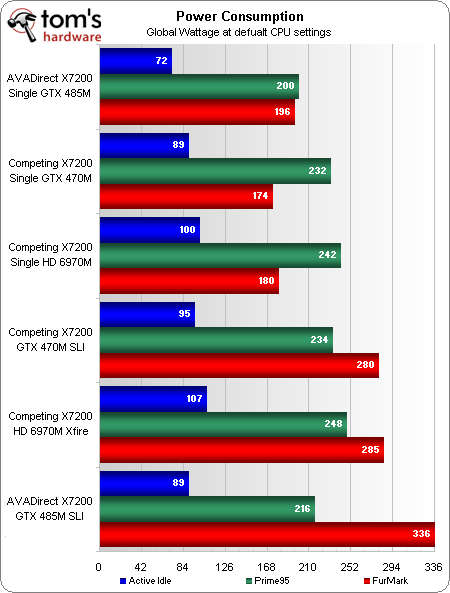AVADirect’s X7200: The GeForce GTX 485M SLI Mobile Graphics Giant
Hot on the heels of Eurocom’s Radeon HD 6970M CrossFire-based launch, AVADirect promises even bigger performance using pair of GeForce GTX 485M modules in SLI. Can AVADirect claim the performance crown at a lower price than its competition?
Power Consumption And Battery Life
AVADirect’s build appears to have lower idle power consumption than any of its competitor’s configurations. Though we have serious doubts about the GeForce GTX 485M’s ability to run 17 W lower at idle than the GeForce GTX 470M, improved GPU power-savings techniques could account for at least part of this improvement. Other system optimizations, such as an improved BIOS from Clevo, an improved CPU stepping from Intel, or even a “luck of the draw” CPU with lower gate leakage could account for the remaining idle power differences.
The GeForce GTX 485M uses far more power than either the GTX 470M or HD 6970M at full load, but appears slightly more miserly at low load. Battery Eater Pro is a great application for applying a low load, and could help us to reveal more about the single 485M’s power behavior.
The single 485M’s big lead in idle power use is seen as a noticeable improvement in battery life. The 485M SLI’s smaller power advantage over the 470M SLI is seen as a far smaller improvement in battery life. That is to say, the battery life chart proves the usefulness of the power consumption chart, at least at idle.
Jumping back up to the top, we also see that FurMark pushes the 485M SLI system to 336W at the wall while using only one CPU thread. Previous tests have shown that a 420W draw trips the power supply’s 15A protection circuit, and that continuous loads of 400 W activate heat protection after several minutes. The possibility that some users will attempt to push both CPU and GPU power limits simultaneously explains why AVADirect supplied this unit with two power bricks. The more-miserly (at full load) Radeon HD 6970M CrossFire configuration gets by (barely) with only one.
Because the Chicony PA09-022A 300 W power brick is roughly twice as big and far less efficient than SilverStone’s 450 W SFX unit, we’re going to make the unprecedented recommendation that Clevo should either design or contract a specialized, 350 W power unit for its next workstation-class notebook using the highest-efficiency components it can find. While high heat in a sealed power supply normally decreases efficiency, a custom design could use an extruded-aluminum, finned housing to cool its components. People who pay thousands of dollars for the “best” hardware would likely tolerate an extra $20-50 added to the notebook’s price in exchange for the added portability of a single power unit.
Get Tom's Hardware's best news and in-depth reviews, straight to your inbox.
Current page: Power Consumption And Battery Life
Prev Page Benchmark Results: 3DMark Next Page Nvidia Returns-
tacoslave these thing are ridiculously expensive. Besides it seems dual gpu's(at least in the mobile sector) scale HORRIBLY in most scenerios.Reply -
LuckyDucky7 Those who really, really need the power, or just have lots of money to blow on stuff like this.Reply
Those who need to process large data sets on the go would likely see lots of use from a machine like this.
Also, those who develop software and need a mobile machine to showcase their new products (especially if that software happens to be a game).
Diminishing returns? Maybe with personal laptops < 1000 dollars. Not with this class of machine. -
Crashman tacoslavethese thing are ridiculously expensive. Besides it seems dual gpu's(at least in the mobile sector) scale HORRIBLY in most scenerios.If you look at the 1920x1080 highest detail results, it's somewhere around 60-80%. I wouldn't call that horrible. You do want to game at the panel's native resolution, no?Reply
-
Maziar Great review as always Crashman :)Reply
Judging from the specs,1 GTX 485M performance falls between a desktop GTX 460 and GTX 560Ti right ? -
Crashman MaziarGreat review as always Crashman Judging from the specs,1 GTX 485M performance falls between a desktop GTX 460 and GTX 560Ti right ?It looks that way on paper...I'm sure there's an X7200 review with a desktop card that you could use to make the conversions.Reply -
Maziar Yep,right.Reply
http://www.tomshardware.com/reviews/malibal-lotus-p150hm-geforce-gtx-485m-core-i7-2920xm,2855.html
But I liked to see a desktop system in the comparison charts. -
silverblue Crysis 1280x720 is a bit of an abberation for the 6970 in Crossfire. Had it not misbehaved there, the result would have been closer, however now AMD have to drop their prices as NVIDIA have brought out a very good solution.Reply -
americanbrian I kind of object to using all of the low resolution results on a configuration like this. It seems like all that it does is skew the results in favour of Nvidia, where in actual fact at the highest details and resolutions (i.e. the targeted area for a gaming laptop) the radeons conclusively win in performance.Reply
I understand that the value proposition is not very good still, but your conclusion is misleading in my opinion. People splashing out to be able to play the most modern games at highest res simply do not care how many excessive frames are pushed at the low end. -
Pointdexter Ok there's something I don't understand : on Eurocom's website an HD6970M costs 475$ LESS than an GTX 485M ... in fact the 6970M costs the same as an GTX 470MReply
so how can an SLI'd GTX 485 could be cheaper than an Xfire'd GTX 485M ?


